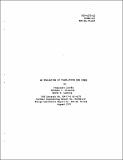| dc.contributor.author | Correa, Francisco | |
| dc.contributor.author | Driscoll, Michael J. | |
| dc.contributor.author | Lanning, David D. | |
| dc.date.accessioned | 2006-06-05T17:35:37Z | |
| dc.date.available | 2006-06-05T17:35:37Z | |
| dc.date.issued | 1979-08 | |
| dc.identifier.other | 06454808 | |
| dc.identifier.uri | http://hdl.handle.net/1721.1/32997 | |
| dc.description | Originally presented as the author's thesis, Ph.D. in the M.I.T. Dept. of Nuclear Engineering, 1979. | en |
| dc.description.abstract | The impact of tight pitch cores on the consumption of natural uranium
ore has been evaluated for two systems of coupled PWR's namely one particular
type of thorium system-U-235/U02: Pu/Th02: U-233/ThO2--and the conventional
recycle-mode uranium system- U-235/U02: Pu/UO . The basic parameter varied
was the fuel-to-moderator volume ratio (F/M) o the (uniform) lattice for the
last core in each sequence.
Although methods and data verification in the range of present interest,
0.5 (current lattices)< F/M < 4.0 are limited by the scarcity of experiments
with F/M > l.0,the EPRI-LEOPARD and LASER programs used for the thorium and
uranium calculations, respectively, were successfully benchmarked against
several of the more pertinent experiments.
It was found that by increasing F/M to "3 the uranium ore usage for the
uranium system can be decreased by as much as 60% compared to the same
system with conventional recycle (at F/M 0.5). Equivalent savings for
the thorium system of the type examined here are much smaller (10%) because
of the poor performance of the intermediate Pu/ThO2 core--which is not
substantially improved by increasing F/M. Although fuel cycle costs
(calculated at the indifference value of bred fissile species) are rather
insensitive to the characteristics of the tight pitch cores, system energy
production costs do not favor the low discharge burnups which might other-
wise allow even greater ore savings (80%).
Temperature and void coefficients of reactivity for the tight pitch
cores were calculated to be negative. Means for implementing tight lattice
use were investigated, such as the use of stainless steel clad in place
of zircaloy; and alternatives achieving the same objective were briefly
examined, such as the use of D20/H20 mixtures as coolant. Major items
identified requiring further work are system redesign to accommodate higher
core pressure drop, and transient and accident thermal-hydraulics. | en |
| dc.description.sponsorship | DOE Contract no. EN-77-S O2-4570. | en |
| dc.format.extent | 7944690 bytes | |
| dc.format.mimetype | application/pdf | |
| dc.language.iso | en_US | en |
| dc.publisher | MIT Energy Laboratory | en |
| dc.relation.ispartofseries | MIT-EL | en |
| dc.relation.ispartofseries | 79-022 | en |
| dc.subject | Nuclear fuel elements. | en |
| dc.subject | Pressurized water reactors. | en |
| dc.title | An evaluation of tight-pitch PWR cores | en |
| dc.type | Technical Report | en |
